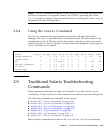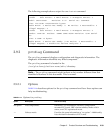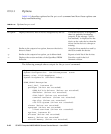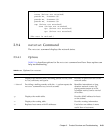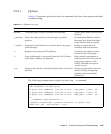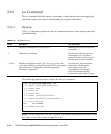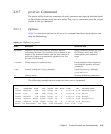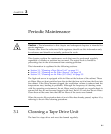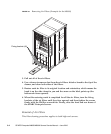
Chapter 2 Product Overview and Troubleshooting 2-45
2.9.5.1 Options
TABLE 2-17 describes options for the ping command and how those options can help
troubleshooting.
The following example shows output for the ping -s command.
TABLE 2-17 Options for ping
Option Description How It Can Help
hostname The probe packet is sent to hostname and returned. Verifies that a host is active on the
network.
-g hostname Forces the probe packet to route through a specified
gateway.
By identifying different routes to
the target host, those individual
routes can be tested for quality.
-i interface Designates which interface to send and receive the probe
packet through.
Enables a simple check of
secondary network interfaces.
-n Replaces host names with IP addresses. Used when an address is more
beneficial than a host name.
-s Pings continuously in one-second intervals. Ctrl-C aborts.
Upon abort, statistics are displayed.
Helps identify intermittent or
long-duration network events. By
piping ping output to a file,
activity overnight can later be
viewed at once.
-svR Displays the route the probe packet followed in one second
intervals.
Indicates probe packet route and
number of hops. Comparing
multiple routes can identify
bottlenecks.
# ping -s teddybear
PING teddybear: 56 data bytes
64 bytes from teddybear (192.146.77.140): icmp_seq=0. time=1. ms
64 bytes from teddybear (192.146.77.140): icmp_seq=1. time=0. ms
64 bytes from teddybear (192.146.77.140): icmp_seq=2. time=0. ms
^C
----teddybear PING Statistics----
3 packets transmitted, 3 packets received, 0% packet loss
round-trip (ms) min/avg/max = 0/0/1



